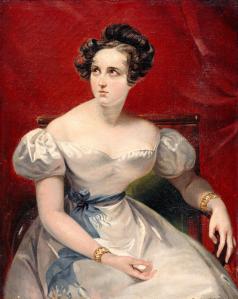Symphonie Fantastique, 5th movement, “Dream of a Witches’ Sabbath”
Hector Berlioz, premiered in Paris, 1830
This Sunday features a different sabbath of sorts: Are you ready for a trip? We’ve got unrequited love, Shakespearean dramatics, opium, poisoning—the whole creepy black kitten and kaboodle. This post is a bit longer, but give it a read. You won’t be disappointed.
Meet Hector.

First of all, can we please take a moment for his hair? I mean, it’s outstanding.
Meet Harriet.

It takes these two a while to meet each other. In 1827 on the still-fated day of September 11, Hector sees Harriet in Paris as she played the role of Ophelia in Shakespeare’s Hamlet, and Hector is a goner. He writes her a bunch of letters, but she never responds. He writes her a symphony, the Symphonie Fantastique, but when it premieres in 1830, she doesn’t come. In Harriet’s defense, she is kinda busy and kind of a big deal. The Irish actress is among the most sought-after actresses, is three years older than this upstart Hector, and she has a lot of fans to deal with.
Let’s take a look at what Harriet passed up. Berlioz composes a little theme that represents Harriet, and it shows up in all five movements of the symphony. It’s known as the idée fixe or “fixed idea” (read, “obsession”) of the symphony. Berlioz uses the symphony to tell a story: The first three movements portray the Artist’s (read, “Hector’s”) rêveries and passions, a lavish ball, and a beautiful pastoral scene. Then the Artist takes some opium and konks out. The fourth and fifth movements depict the Artist’s dreams while under the influence. In the fourth movement, the Artist dreams he has killed his beloved and is marched to the scaffold for his execution. Berlioz wrote in the Artist’s last thought of the beloved in the idée fixe (heard in the clarinet solo), the sound of the head being sliced off, even the sound of it rolling into the basket, and the audience cheering the event. No, really. You can hear that bit here.
So if the Artist dies in the fourth movement, what happens in the fifth? Halloween music is what happens. Entering the world of the dead, the Artist meets the unruly crowd of the underworld. They shriek and cavort, and they clearly pay homage to one figure in particular. It is she, but she’s a witch, the grandmammy witch of them all. The lovely idée fixe is ghoulishly distorted into a cackling jig (see the piece at 1:34). Bells toll (2:48)—hells bells, as my grandpa would say—and this witchy idée fixe mixes with the medieval funeral tune Dies irae (3:15) which represents the wrath of hellish suffering. You can hear both tunes throughout the movement. Berlioz pulls out all the stops; at one point the violins turn their bows and play on the wooden sticks to imitate the sound of bones jangling (8:16). Basically, the whole spooky party dances it out. Leonard Bernstein, who conducts the version posted here, said, “Berlioz tells it like it is. You take a [drug] trip, you wind up screaming at your own funeral.” Harriet missed a good show.
By 1832, however, circumstances have changed. Harriet is out of money, and, defying the very meaning of the word “premiere”, Hector has somehow arranged for a second premiere of the symphony for his beloved. He sends her the best tickets, and she goes! The audience loves it. Harriet gets it. And finally, at long last, she agrees to meet him.
They get married.
But, shockingly, this now-celebrity marriage doesn’t go so well. They fight a lot and end up separating; in essence, they sort of act out the story Berlioz tells in the symphony. So this begs the question: was Berlioz just on a crazy opium trip when he wrote Symphonie Fantastique or was he prophetic? The moral of the story is that if you ever write a symphony, be careful what you compose.


Be careful what you compose and publicize, especially. I love your storytelling here, by the way. Also, somehow, last year when I was in a symphony performing this piece, I missed that the bow-stick-on-string (col legno) part was supposed to be bones jangling. That makes it a lot more fun.
LikeLike